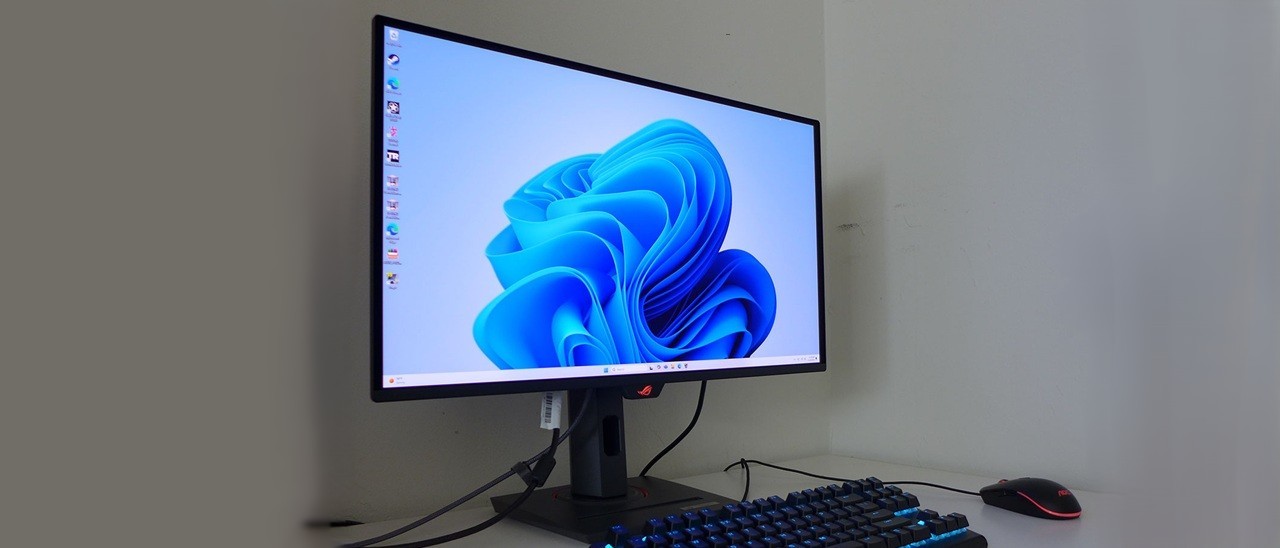Why you can trust Tom's Hardware
The XG27ACDNG includes a factory calibration, which can be used in the Racing picture mode. If you want to tweak, there are color temps and gamma presets. You can also change the gamut volume between sRGB, DCI-P3, and Native, which is a little more colorful than P3.
Grayscale and Gamma Tracking
Our grayscale and gamma tests use Calman calibration software from Portrait Displays. We describe our grayscale and gamma tests in detail here.
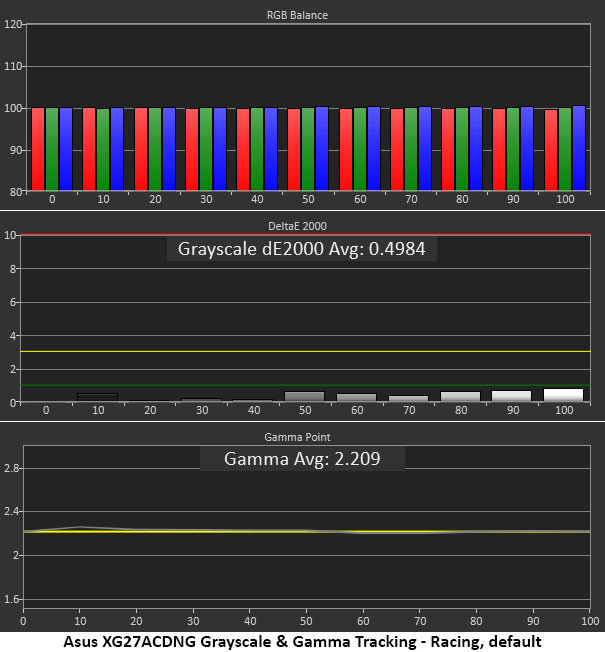
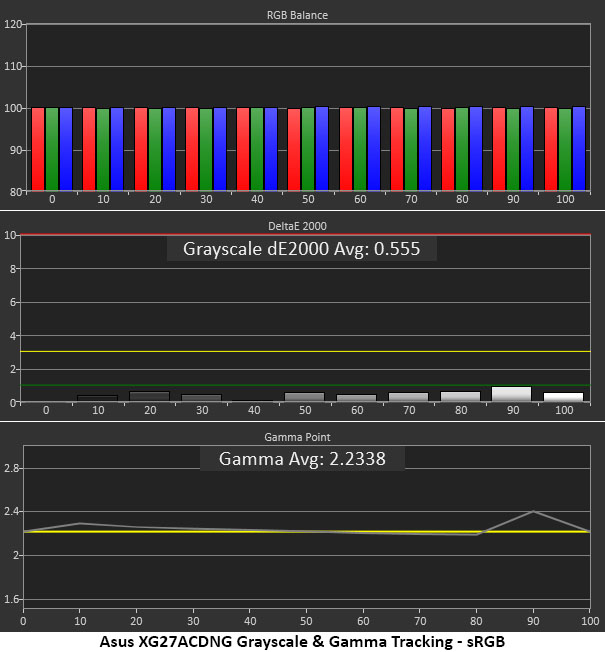
The XG27ACDNG’s default grayscale chart is as close to perfect as I’ve ever seen. RGB tracking and gamma are so close to the reference line that you can barely see the traces. It truly doesn’t get better than this. However, no improvement was found when I attempted a calibration, so there are no additional results to show.
The sRGB chart is nearly flawless except for a bump in gamma at the 90% step which means it’s too dark at that level. It manifests as slightly muted highlights, but the effect is subtle. If you need sRGB accuracy, the XG27ACDNG provides it.
Comparisons
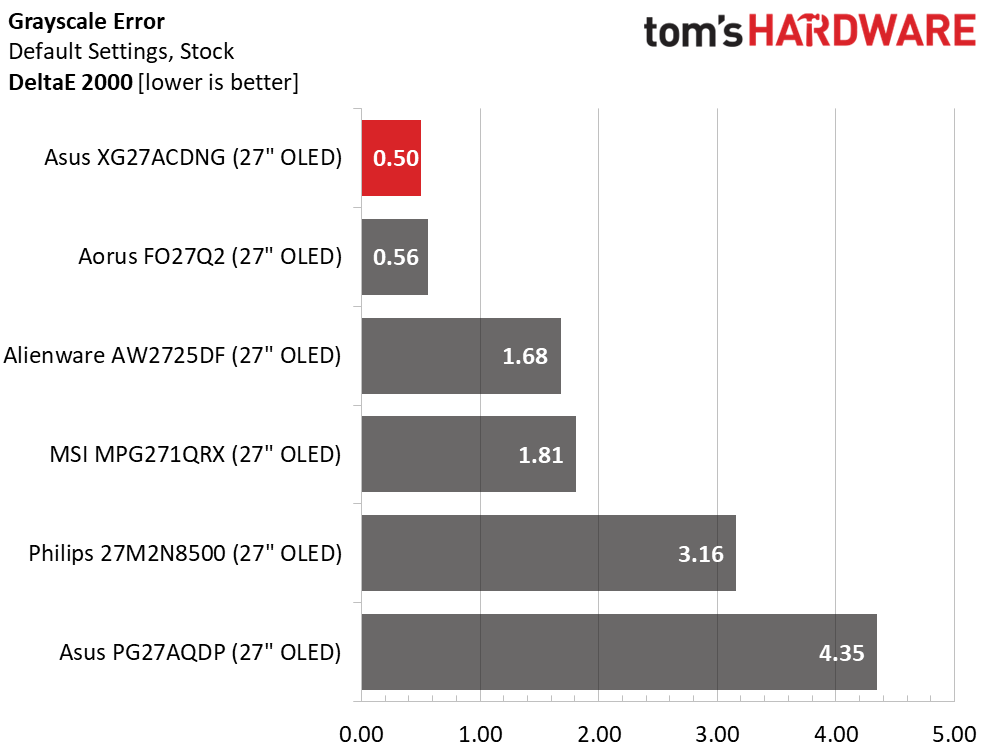
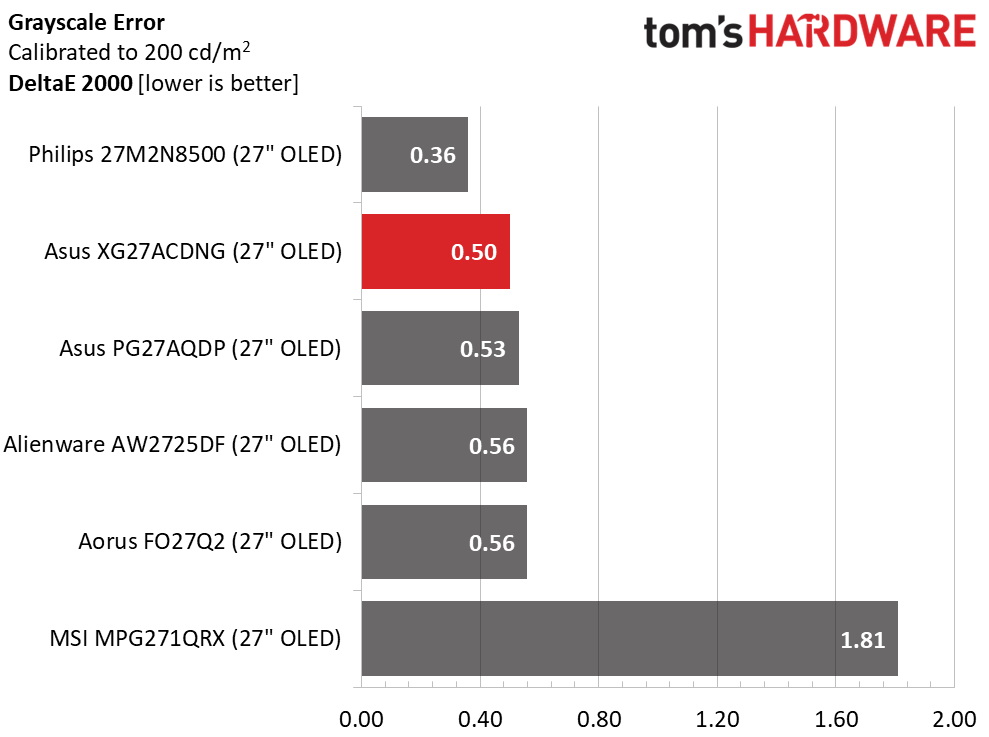
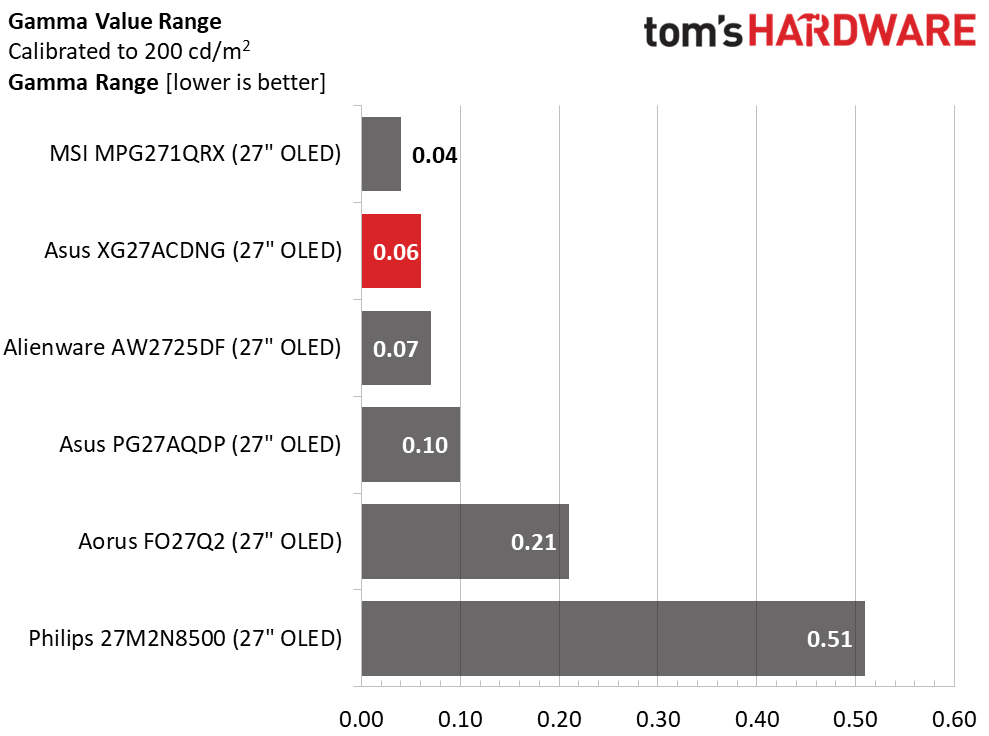
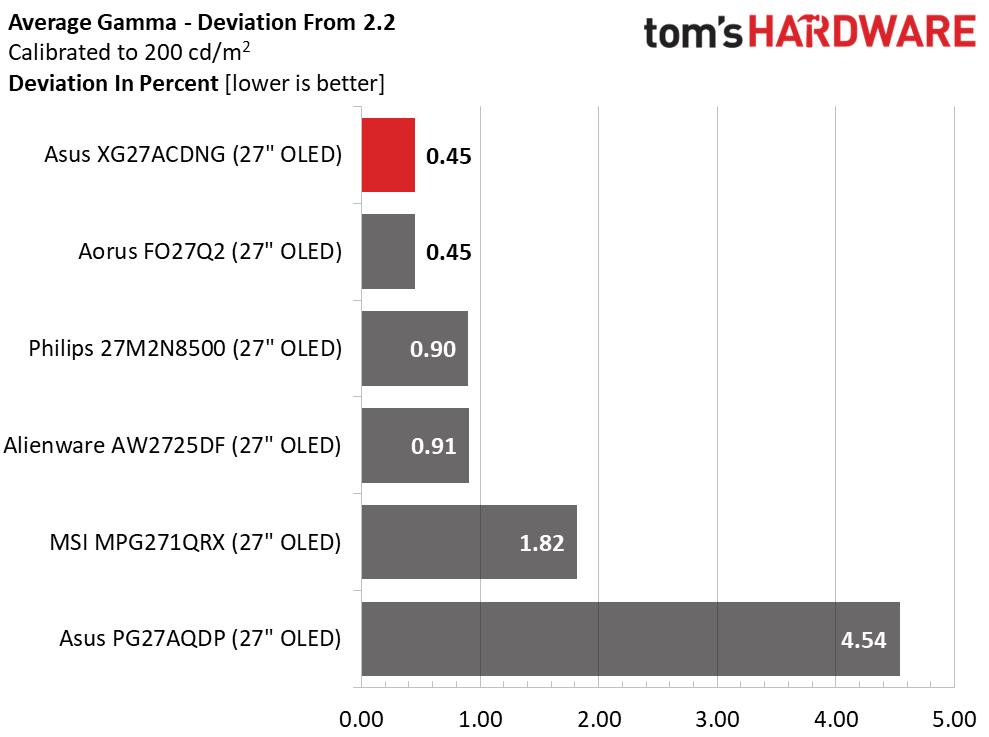
I charted the XG27ACDNG’s 0.50dE value against the other screens in both the pre- and post-calibration comparisons and it doesn’t get much better. Only the Philips managed to eke out first place after adjustment. Visually, there is no difference between any of the monitors.
The XG27ACDNG’s gamma is spot on as well. The range of values is just 0.06 and it rides 0.45% off the 2.2 reference with an actual value of 2.21. These errors are wholly invisible in actual content.
Color Gamut Accuracy
Our color gamut and volume testing use Portrait Displays’ Calman software. For details on our color gamut testing and volume calculations, click here.
Get Tom's Hardware's best news and in-depth reviews, straight to your inbox.
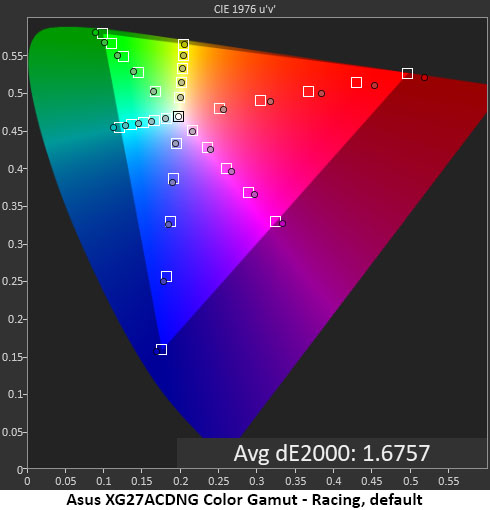
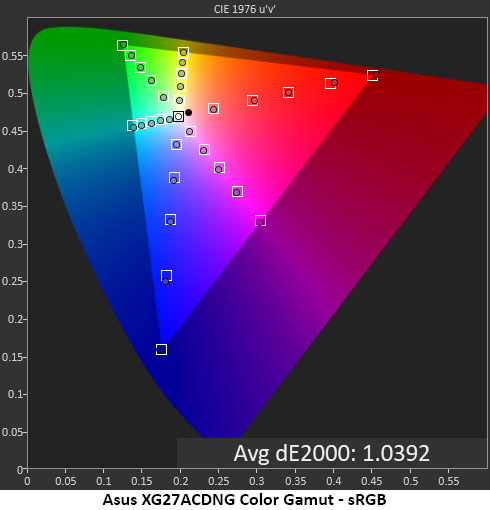
The XG27ACDNG is a bit over-saturated like all Quantum Dot monitors. This is not a bad thing. With no visible hue errors and linear saturation tracking, there is nothing to complain about. Again, calibration cannot improve upon the result.
The sRGB chart is reference-level as well. I achieved this by changing the color space option in the Color menu rather than employing the sRGB Cal picture mode. Doing it that way means you can still adjust all image parameters like gamma and color temp. sRGB Cal limits changes to Brightness only.
Comparisons
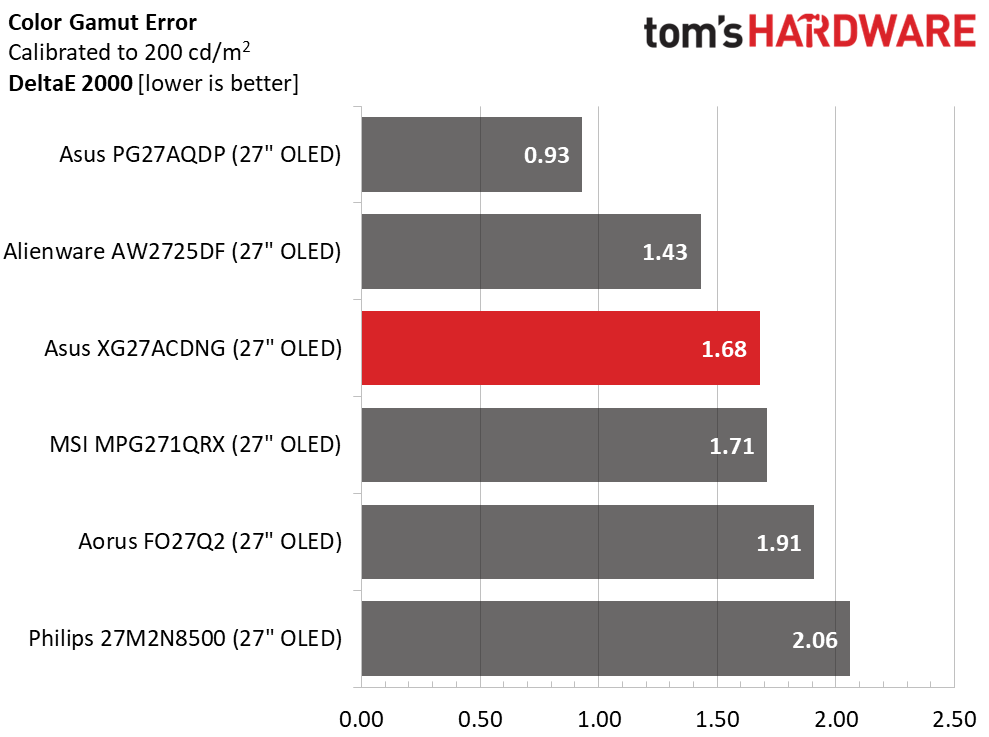

The XG27ACDNG posts an impressively low color error of 1.68dE, but it should be noted that it is not the only screen that achieves this without calibration. I also left the Aorus and MSI screens at their defaults because calibration didn’t improve them either. It’s safe to say that this category is extremely color-accurate and often does not need adjustment for great color.
The XG27ACDNG’s Quantum Dot tech makes it the first OLED I’ve measured over 111% for color volume when referenced to DCI-P3. It also covers an ideal 101.7% of sRGB. Accuracy is high enough for critical apps in the sRGB and DCI-P3 realms. And it’s currently the most colorful OLED you can buy.
Test Takeaway: There’s not much to say about the XG27ACDNG’s color other than that it is supremely accurate and supremely saturated. It’s a standout monitor that will satisfy anyone with its stunning and colorful image.
MORE: Best Gaming Monitors
MORE: How We Test PC Monitors
MORE: How to Buy a PC Monitor
Current page: Grayscale, Gamma and Color
Prev Page Brightness and Contrast Next Page HDR Performance
Christian Eberle is a Contributing Editor for Tom's Hardware US. He's a veteran reviewer of A/V equipment, specializing in monitors. Christian began his obsession with tech when he built his first PC in 1991, a 286 running DOS 3.0 at a blazing 12MHz. In 2006, he undertook training from the Imaging Science Foundation in video calibration and testing and thus started a passion for precise imaging that persists to this day. He is also a professional musician with a degree from the New England Conservatory as a classical bassoonist which he used to good effect as a performer with the West Point Army Band from 1987 to 2013. He enjoys watching movies and listening to high-end audio in his custom-built home theater and can be seen riding trails near his home on a race-ready ICE VTX recumbent trike. Christian enjoys the endless summer in Florida where he lives with his wife and Chihuahua and plays with orchestras around the state.
-
Mr Majestyk So who cares about colour accuracy for a gaming monitor? No way in hell I'd buy OLED for productivity.Reply -
UnforcedERROR Reply
Color accuracy is arguably one of the most important parts of a monitor, regardless of intended use.Mr Majestyk said:So who cares about colour accuracy for a gaming monitor? No way in hell I'd buy OLED for productivity. -
HardwiredWireless Reply
Exactly. The dinky little screen is a major drawback for gaming or productivity for me. After using an ultra wide curved screen this little thing is unusable regardless of it's claimed features. Instead of the old OLED screens the better looking and newer tech is using individually lighted LEDs which eliminated the overnighting in darker areas but still allows for a much brighter picture that is the Hallmark of traditional LED screens. I'm more interested in the area of the screen that are showing an image than the areas that are turned off anyways to be honest, but for the folks that like the non image darkness the new systems offer that too.Mr Majestyk said:So who cares about colour accuracy for a gaming monitor? No way in hell I'd buy OLED for productivity. -
UnforcedERROR Reply
MicroLED and QDEL are unlikely to be on the market anytime soon. Also, ultrawides and this monitor serve entirely different gaming demographics. One is for immersion across most games and the other is primarily aimed at FPS. But ultimately caring about color accuracy isn't just a productivity thing, it makes anything you interact with look better.HardwiredWireless said:Exactly. The dinky little screen is a major drawback for gaming or productivity for me. After using an ultra wide curved screen this little thing is unusable regardless of it's claimed features. Instead of the old OLED screens the better looking and newer tech is using individually lighted LEDs which eliminated the overnighting in darker areas but still allows for a much brighter picture that is the Hallmark of traditional LED screens. I'm more interested in the area of the screen that are showing an image than the areas that are turned off anyways to be honest, but for the folks that like the non image darkness the new systems offer that too. -
HardwiredWireless Reply
More accurate color representation doesn't necessarily look better It just looks more accurate It might look better to a person if they switch to hue slightly to lower or to the redder. What looks better is subjective what looks more accurate is objective.UnforcedERROR said:MicroLED and QDEL are unlikely to be on the market anytime soon. Also, ultrawides and this monitor serve entirely different gaming demographics. One is for immersion across most games and the other is primarily aimed at FPS. But ultimately caring about color accuracy isn't just a productivity thing, it makes anything you interact with look better. -
UnforcedERROR Reply
Yes, but what you're failing to understand is that if you start with accurate, and you don't like it, it's easier to adjust to your preferences. When something is wildly out of spec it's not only harder to correct, it may be impossible depending on the error variance. You always want to start with the best possible outcome, not the worst.HardwiredWireless said:More accurate color representation doesn't necessarily look better It just looks more accurate It might look better to a person if they switch to hue slightly to lower or to the redder. What looks better is subjective what looks more accurate is objective. -
HardwiredWireless Reply
The starting point has nothing to do with the ease of changing the settings.UnforcedERROR said:Yes, but what you're failing to understand is that if you start with accurate, and you don't like it, it's easier to adjust to your preferences. When something is wildly out of spec it's not only harder to correct, it may be impossible depending on the error variance. You always want to start with the best possible outcome, not the worst. -
UnforcedERROR Reply
Doesn't it? Does inaccuracy make changing them easier? What exactly is your point supposed to be? If you don't have to adjust for accuracy out of the box is that not easier at a base level than if you want that performance and it can't achieve it? Even if you prefer it inaccurate, that initial built-in inaccuracy may not be to your liking, which makes the situation even more convoluted.HardwiredWireless said:The starting point has nothing to do with the ease of changing the settings.
There's no logic to the point you're making.
EDIT: Also who was even talking about ease of changing settings? I'm talking strictly about color accuracy, not functionality. Sorry, I'm not trying to be a jerk, I just find it to be non-correlative to the discussion. -
HardwiredWireless Reply
The point I'm making is if I want my screen to be purple I still have to make the same adjustments whether it's slightly green slightly blue slightly orange or dead on perfect to start with. There's also a huge difference between transmitted light and color and reflected light and color which you would understand if you've ever done any printing. What you see on the screen does not really look like what it is when it's printed out. A Pantone color on the screen looks far different than a Pantone color in the book.UnforcedERROR said:Doesn't it? Does inaccuracy make changing them easier? What exactly is your point supposed to be? If you don't have to adjust for accuracy out of the box is that not easier at a base level than if you want that performance and it can't achieve it? Even if you prefer it inaccurate, that initial built-in inaccuracy may not be to your liking, which makes the situation even more convoluted.
There's no logic to the point you're making.
EDIT: Also who was even talking about ease of changing settings? I'm talking strictly about color accuracy, not functionality. Sorry, I'm not trying to be a jerk, I just find it to be non-correlative to the discussion. -
UnforcedERROR Reply
But your point makes no sense: what if the color cannot be calibrated to your preference because the errors are too present to properly correct? This can be a problem to some degree, depending on the quality of display. Again, starting from perfect and adjusting to preference will always be better than starting in error and adjusting to preference. Obviously you can use calibration tools to get closer to a preferred spec, but not everyone has access to those (and, again, it may not be able to fully correct for errors depending on severity).HardwiredWireless said:The point I'm making is if I want my screen to be purple I still have to make the same adjustments whether it's slightly green slightly blue slightly orange or dead on perfect to start with. There's also a huge difference between transmitted light and color and reflected light and color which you would understand if you've ever done any printing. What you see on the screen does not really look like what it is when it's printed out. A Pantone color on the screen looks far different than a Pantone color in the book.
Also, you don't have to lecture me on the difference between print and screen. I'm a professional designer as well as a trained lithographer and fine artist. There is very little I don't know about color theory. Trust me, I'm keenly aware that you want a Pantone book to properly match colors if you're not working in CMYK (and if you're in CMYK between printers you should press-check). All that said, color accuracy extends into film media, it's not just about professional use.
